Affordable Housing & Energy Performance
Learning Objectives:
- Explain how public policy and funding streams help affordable housing achieve high levels of energy performance.
- Discuss how materials choices can save money while supporting occupants’ health and well-being.
- Describe strategies for designing housing to reduce energy demand during peak hours.
- Outline the anticipated schedule and energy-performance advantages of the structural and envelope systems designed for 981 Davie.
Credits:
This course is approved as a Structured Course
This course can be self-reported to the AANB, as per their CE Guidelines
Approved for structured learning
Approved for Core Learning
This course can be self-reported to the NLAA
Course may qualify for Learning Hours with NWTAA
Course eligible for OAA Learning Hours
This course is approved as a core course
This course can be self-reported for Learning Units to the Architectural Institute of British Columbia
View course on architecturalrecord.com »
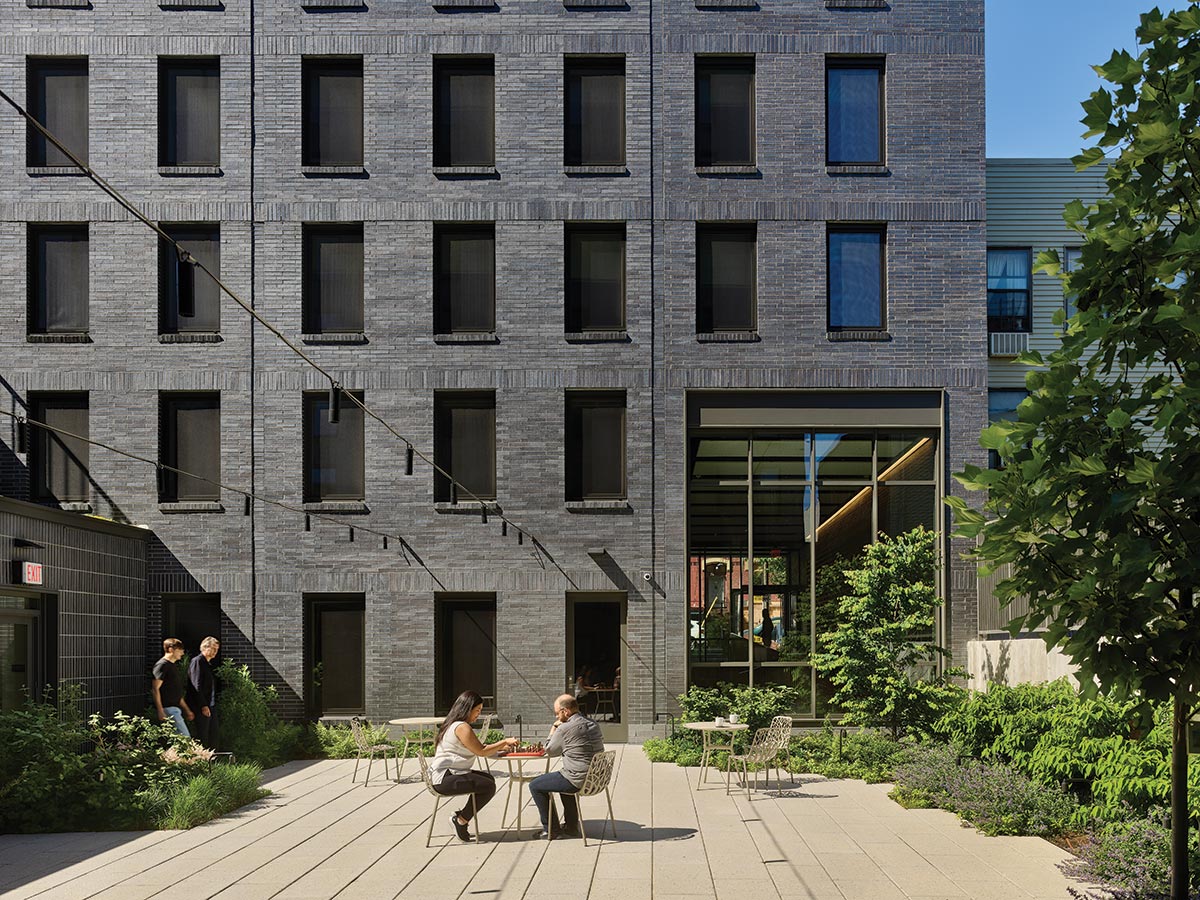
PHOTOGRAPHY: © FRANK OUDEMAN
Betances Residence, in the Bronx, New York, restores the urban streetwall at the front facade (below), but has a courtyard at the rear (above).
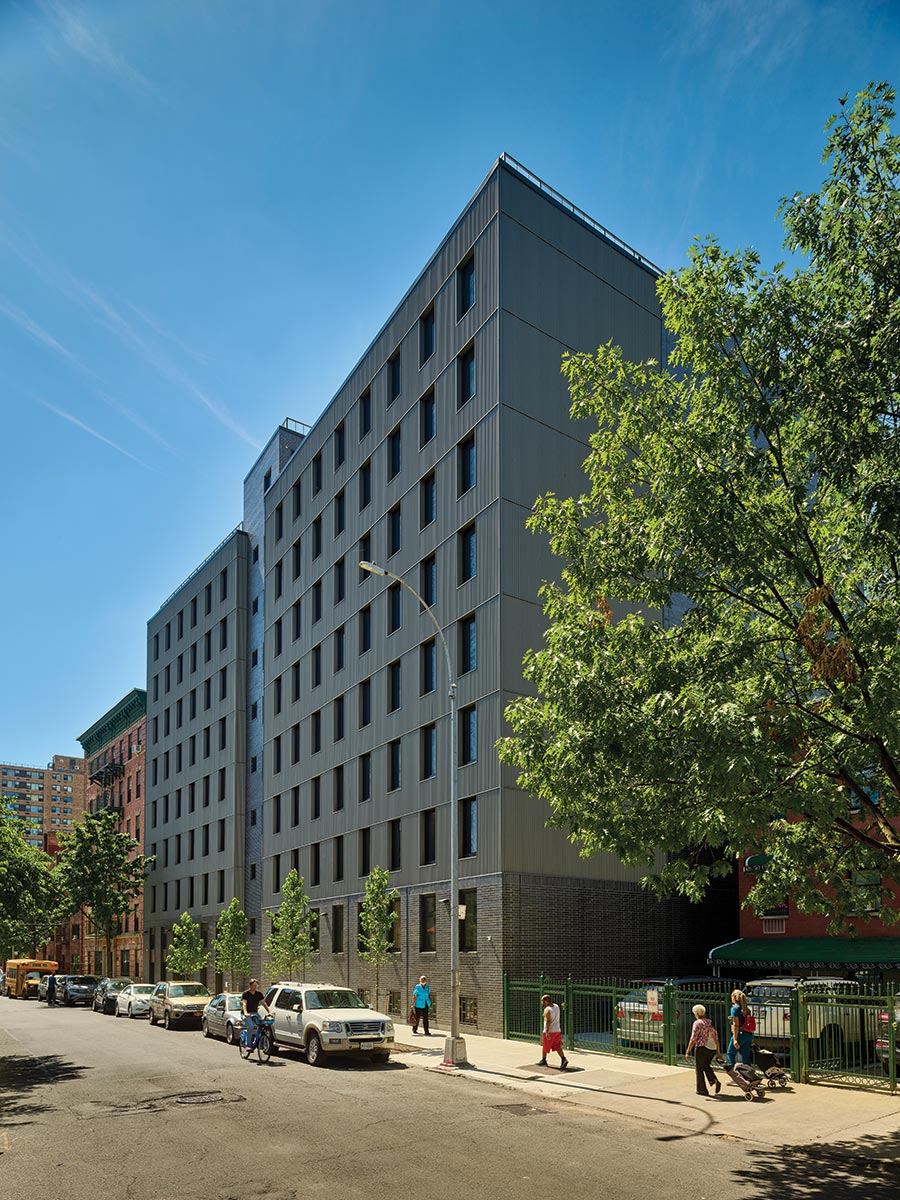
PHOTOGRAPHY: © FRANK OUDEMAN
It sometimes seems as though the affordable-housing sector—which is presumably watching every dollar to scrimp or scrounge—regularly achieves standards of energy performance and livability that much of the market-driven sector barely aspires to.
The square footage of Passive House–certified multifamily development, for example, has more than tripled in the last five years, with affordable housing accounting for over 90 percent of the sector, according to Phius, a Passive House training, advocacy, and certification nonprofit. Similarly, the number of affordable-housing projects registered with one of the certification programs administered by the International Living Future Institute (ILFI) has more than doubled in the same period, with even more projects piloting the Living Building Challenge Affordable Housing Framework. Nearly 80 percent of multifamily projects that certified as GreenPoint Rated between 2020 and 2024 are affordable, with a dramatic upswing in the percent achieving the Gold or Platinum level. Under LEED, 438 affordable-housing developments, representing 6,521 units, achieved certification in 2023 alone.
What’s driving the sector’s sustainability and livability achievements, how do ambitious goals fit into tight budgets, and are there lessons for fostering more environmentally and socially responsible multifamily housing nationwide? RECORD put these questions to Phius, ILFI, and the design teams behind three outstanding affordable-housing projects: Betances Residence, a Passive House–certified senior residence in the Bronx, New York, by COOKFOX Architects; Coliseum Place, a Living Building Challenge Affordable Housing Pilot and GreenPoint Rated Platinum building in Oakland by David Baker Architects (DBA); and 981 Davie Street, a Passive House–aspiring tower in Vancouver, British Columbia, by ZGF Architects.
The ambitions of all three projects, and similar achievements sector-wide, can be largely explained by three primary factors. The first is developers’ social mission: “It’s not only about housing—it’s about quality housing,” says Darin Reynolds, a partner with COOKFOX. And, even though housing is the core mission, adds Katie Ackerly, a principal and sustainable-design director at DBA, “that purpose often aligns with making the world a better place in multiple ways.” The health impacts of the built environment are especially significant in the affordable sector, “more so than for market-rate buildings,” says Susan Puri, affordable-housing director at ILFI, referring to data that correlate low-income communities with poor air quality and other environmental hazards, “because for a long time the built environment has perpetuated social inequities.”
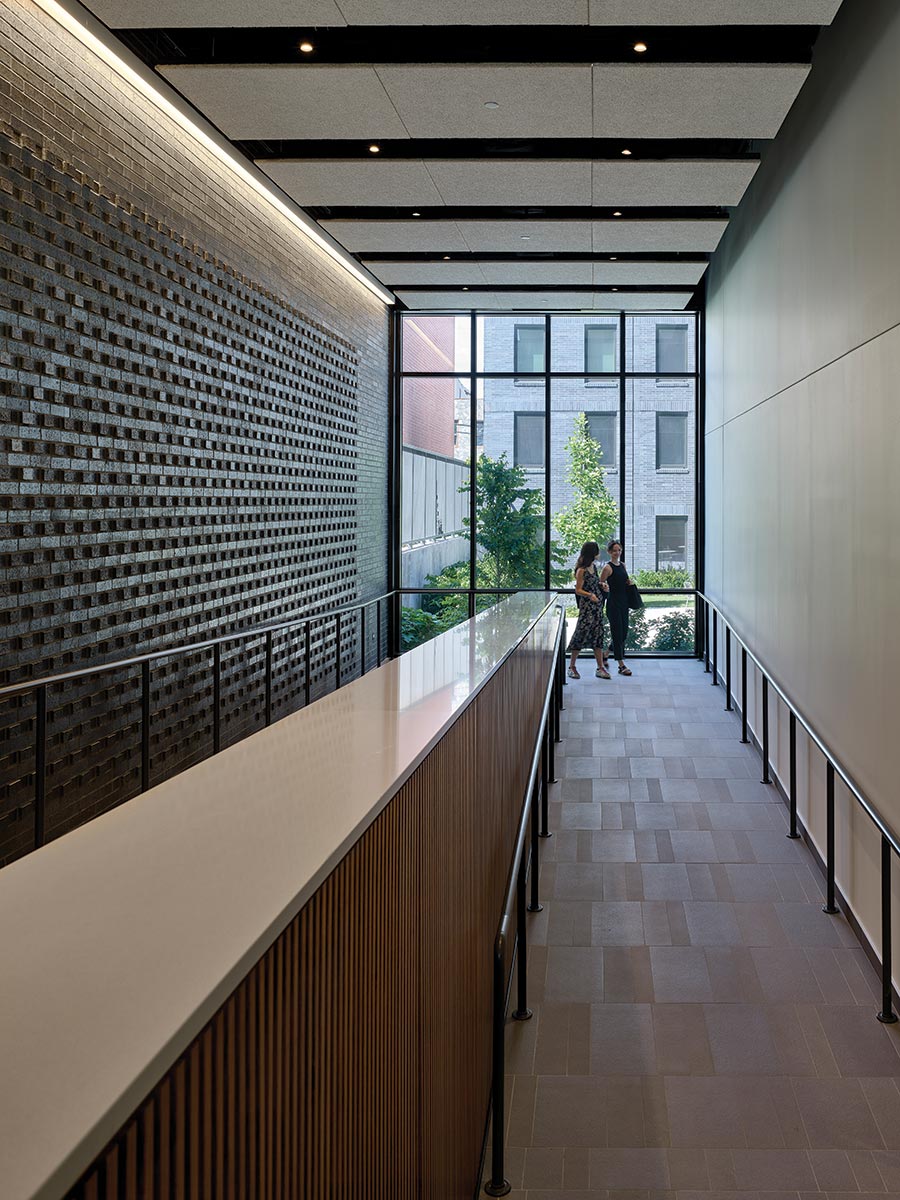
PHOTOGRAPHY: © FRANK OUDEMAN
Social spaces (below) at Betances look out onto the courtyard as does the lobby (above), where light from a generous window calls attention to the texture of its corbelled brick wall.
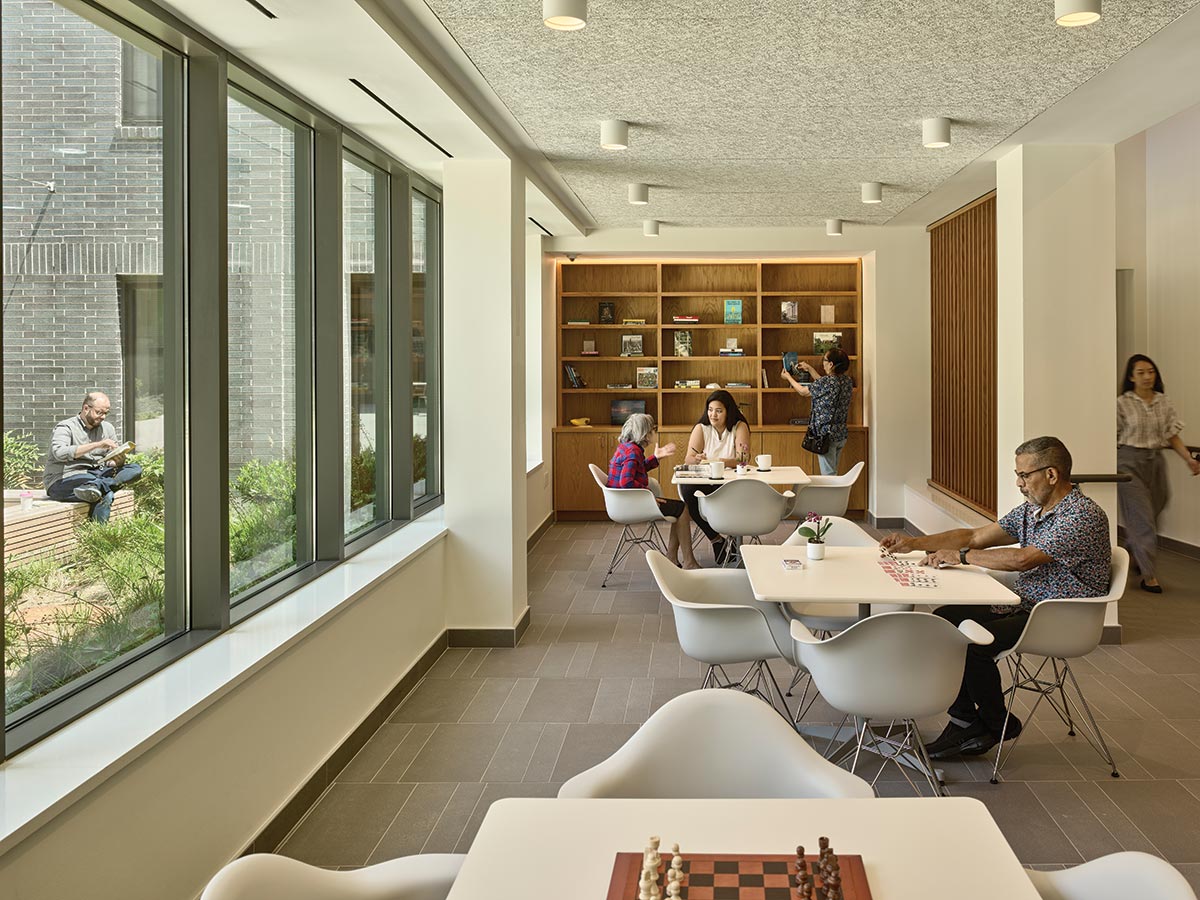
PHOTOGRAPHY: © FRANK OUDEMAN
The second factor is social policy, especially when it’s expressed through funding criteria and incentives. For example, federal low-income-housing tax-credit programs (LIHTC), which provide a significant portion of many affordable developments’ budgets, are distributed through competitive programs (known as qualified allocation plans, or QAPs) run by state housing-finance agencies. A growing number of QAPs award points for environmental responsibility. In fact, Phius largely attributes the surge in the sector’s uptake of Passive House to incentives in the QAPs of more than 17 states.
The third factor linking affordable housing and building performance is long-term ownership, which aligns both with social housing developers’ mission and with common funding requirements. LIHTC-funded projects, for example, are required to preserve their affordability for 30 years. With a long-term view, reduced operating costs can more than reimburse up-front premiums, if any, associated with developing a high-performance building (as long as funders’ caps on per-unit costs don’t get in the way).
These three factors—client mission, funding-backed policy, and long-term ownership—pushed the performance goals of each of the three example projects. The specifics of the achievements and the strategies for realizing them on limited budgets vary with the circumstances unique to each project.
For Betances Residence, requirements to provide below-market housing for seniors, to certify under Enterprise Green Communities (a point-based environmental standard for affordable housing), and to achieve exemplary energy performance came as conditions of funding. Built on two formerly empty lots, one owned by the New York City Housing Authority and the other by New York City Housing Preservation and Development, the Passive House–certified Betances provides 152 units of supportive housing for at-risk seniors and achieves a 69 percent reduction in energy-use intensity (EUI) compared to a baseline building (17.4 kBtu/sf/yr versus 56). The eight-story structure, completed in 2022, was built for $560 per square foot and $440,000 per unit. The developer, Breaking Ground, says the budget is in line with comparable affordable multifamily projects where requirements for paying the local prevailing wage apply, and Reynolds says it’s significantly lower than a market-rate development.
To get the most bang for the buck, Betances is designed to maximize floor area within a tight zoning envelope. Much of the ground floor is recessed more than 50 percent below grade, a move that gains almost an entire story of usable space in addition to the zoning-allowed floor area. A central courtyard, also recessed, provides daylight and views that make the library, social services, and other common areas on this floor feel as though they’re at grade. Further boosting the buildable square footage, an economical block-and-plank structure, consisting of CMU bearing walls and precast concrete-plank floor slabs, makes a floor-to-floor height of 9 feet viable. This enabled more units to be constructed within the site’s height limit while still providing ceilings of 8 feet and higher for residents.
A high-performance envelope and energy-recovery ventilators provide benefits beyond energy savings. These include quality indoor air in a neighborhood with some of the worst asthma rates in the country and quiet interiors despite the proximity of highway traffic.
The building’s material palette was carefully selected to reinforce the project’s values. Cost-effective brick cladding conveys a sense of dignity and permanence that’s especially welcome in what may be residents’ first experience of housing stability in years. Brick also lines the walls of the lobby, where it is corbelled to create patterns and plays of shadow in the daylight from generous windows to the courtyard. The lobby brick doesn’t add significant cost, Reynolds says, “but it adds an incredible value for the people who are experiencing that space.” Other common-area materials, chosen for their evocation of nature, include wood slats along the lobby ramp and wood-fiber ceiling panels, a low-cost choice for softening the space’s acoustics. “We’re trying to achieve multiple things through simple choices,” Reynolds says. “For a client like Breaking Ground, which provides social services to their tenants, designing to support occupants’ health and well-being can help save money in the long run.”
As with Betances, the social and environmental performance of Coliseum Place, completed in 2022, resulted from a combination of funding- and mission-driven priorities. Located beside a commuter rail station, the six-story, 59-unit development for low-income and formerly unhoused families is adjacent to what’s intended to become a larger transit-oriented development. With the nonprofit developer Resources for Community Development seeking to surpass the LEED Platinum rating that had become its standard, the project enrolled in the ILFI Affordable Housing Pilot. Pilot projects attempt a range of ILFI certifications (including Living Building Challenge, Core, Zero Carbon, and Zero Energy), with access to educational sessions, peer-to-peer discussions, and support from the institute’s technical staff, all with the goal of breaking down barriers to deep-green housing. “We learned a ton about what’s appropriate for affordable housing in terms of these aspirational goals,” says DBA’s Ackerly—“what it takes to get there, and also what it means when a certification is driving your goal-set versus supporting a set of inherent goals and quality assurance.”
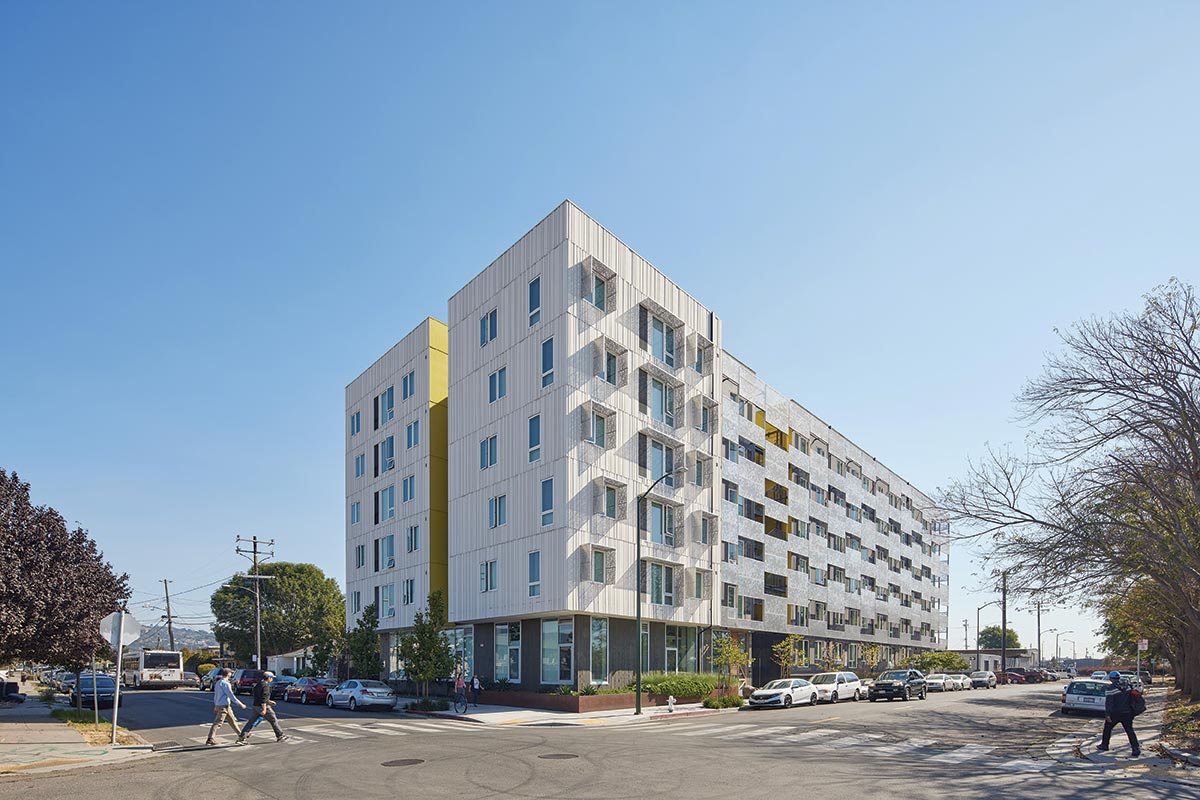
IMAGES: © BRUCE DAMONTE
Coliseum Place in Oakland, California, has a landscaped podium (below) and is wrapped in a shade screen (above).
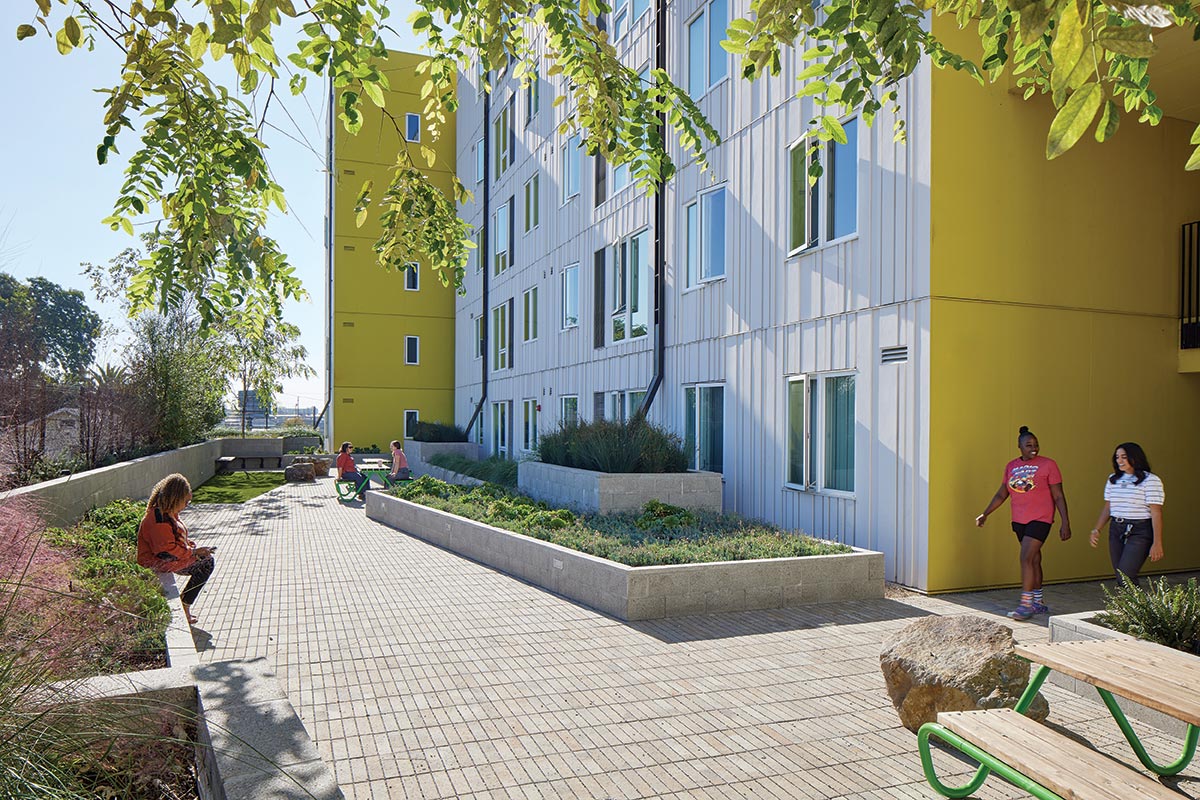
IMAGES: © BRUCE DAMONTE
















